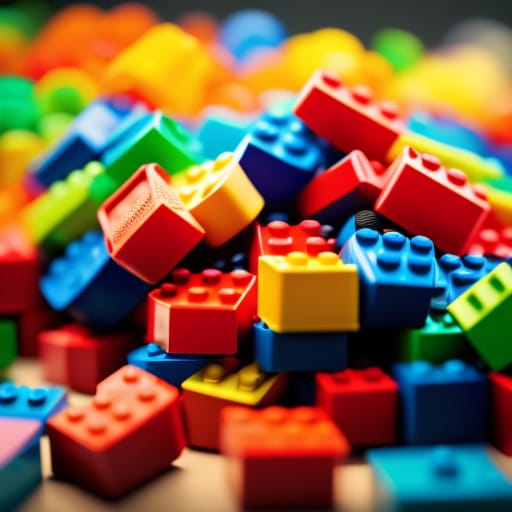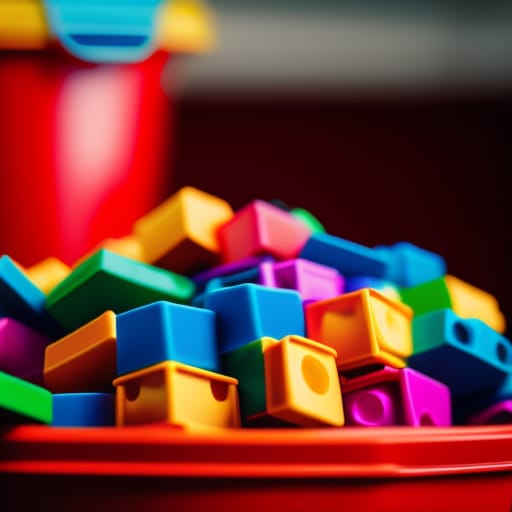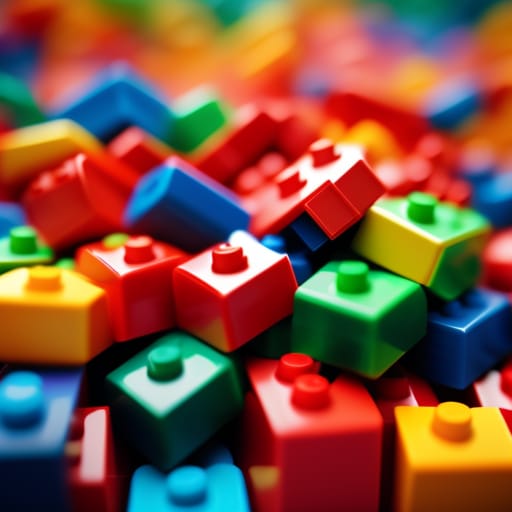Lego bricks are more than just toys – they are an integral part of many childhoods and a creative medium for children and adults alike. This comprehensive beginner’s guide will teach you all about the iconic Lego Building Blocks and their evolution over the decades.

What Are Lego Bricks?
Lego bricks are interlocking plastic building blocks that can be assembled to construct various objects like vehicles, buildings, robots, and more. The classic Lego bricks are made of acrylonitrile butadiene styrene (ABS) polymer and come in a variety of colors and sizes.
The name Lego comes from the Danish phrase “leg godt” meaning “play well”. The basic Lego brick design featuring the studs and tubes has remained virtually unchanged since its patent in 1958. But Lego has expanded into many themed sets featuring licensed characters from movies, TV shows, video games, and more.
The classic Lego bricks are known for their versatility and ability to interlock.
Some key facts about Lego:
- Invented in 1949 in Billund, Denmark
- Interlocking brick patent filed on 28th January 1958
- The current parent company is The Lego Group based in Denmark
- Lego bricks are produced at factories in Denmark, Hungary, China and Mexico
- There are approximately 62 Lego bricks per person in the world
Over 600 billion Lego elements have been produced since 1958 – enough to circle the world over 120 times!
A Brief History of Lego
The Lego story started in a small carpentry workshop in Billund, Denmark run by Ole Kirk Christiansen. In 1934, he began making wooden toys and named his company “Lego” – derived from the Danish phrase leg godt meaning “play well”.
It was only in 1949 that the company began producing the now famous interlocking plastic Lego bricks after purchasing an injection molding machine. The bricks were originally marketed as toy building blocks that allowed children to construct houses, vehicles, and more.
Over the next few decades, Lego expanded its offerings by:
- Adding more bricks like windows and doors in the 1950s
- Introducing the first Lego wheels in 1961
- Launching the first Lego figures in 1978
- Inventing the stud and tube coupling system in 1958 that allowed bricks to interlock securely
In the 1980s and 90s, Lego transitioned into a modern toy company with licensed themes like Star Wars, Harry Potter, Superheroes, and more. It also expanded into amusement parks, video games, movies and board games.
Some notable dates:
- 1958 – Interlocking building brick patent filed
- 1978 – Mini figures with limbs, hair, and faces launched
- 1999 – The Lego Star Wars collection released
- 2014 – The Lego Movie hits theaters
- 2020 – Lego Super Mario interactive sets launched
Today the Lego Group produces over 20 billion bricks each year and Lego sets are sold around the world. Lego Building Blocks remain one of the most popular toys globally.
Benefits of Lego Bricks for Child Development
Lego bricks are beloved by children for their versatility and ability to foster creativity. But they also provide many developmental benefits that make them ideal educational toys.
Enhances Motor Skills
Snapping Lego bricks together involves precision and concentration. Assembling intricate sets helps improve fine motor control in children.
Encourages Creativity
With no fixed designs, Lego sets allow kids to build anything they can imagine. This ability to engage in creative play boosts problem solving abilities and self-expression.
Improves Spatial Intelligence
Visualizing and assembling complex Lego structures requires spatial reasoning skills. Lego bricks activate and strengthen areas of the brain responsible for spatial intelligence.
Teaches STEM Concepts
Lego sets like Lego Mindstorms that involve programming, Lego Architecture, and Lego Technic provide full STEM learning experiences involving science, technology, engineering, and math.
Develops Patience and Focus
Following Lego building instructions or handling challenging builds demands persistence, attention to detail, and patience from kids.
Promotes Cooperation
Big Lego projects become opportunities for teamwork as children coordinate to build together. Communication, collaboration, and sharing are encouraged.
So using Lego goes far beyond just playing – it actively contributes to a well-rounded education for children.
Types of Lego Building Blocks
While the classic Lego brick is the foundation, Lego Elements come in a variety of shapes, sizes, and colors today. Here are some of the main types you’ll encounter:
Standard Bricks – The classic rectangular blocks featuring rows of studs used to construct the core of models. They come in many colors and a range of sizes.
Plates – These are flat, square Lego pieces with studs on top that are used to build surfaces and roofs. Plates form the surfaces of Lego creations.
Tiles – Similar to plates but tiles have no studs. They offer completely smooth flat surfaces and interesting patterns.
Modified Bricks – These feature alterations from the basic brick design and come in many variations like with pegs, curved surfaces, hinges, and more.
Baseplates – These flat pieces with studs form the foundation to build on. Lego baseplates come in sizes like 16×16, 32×32, and 48×48 studs.
Minifigures – The classic 4cm tall Lego people models that can be customized with various parts. They remain hugely popular.
Technic – Advanced models like gears, beams, axles, and pins that allow movement and mechanical functionality. Used in Lego Technic sets.
Duplo – Larger bricks suitable for younger kids under age 4. Not compatible with standard Lego System bricks.
There are thousands of unique Lego elements catering to every building need imaginable!

Popular Lego Brick Themes and Sets
While plain Lego bricks foster open-ended creativity, Lego also provides many themed sets featuring popular movies, TV franchises, buildings, and more.
Lego City
This range features realistic city life settings like police stations, fire trucks, construction sites, and coastal scenes. A classic that sparks roleplaying.
Lego Friends
Geared towards girls, the Friends line includes characters, houses, cafes, shops, and cute pets in the Heartlake City.
Lego Star Wars
Features every kind of model from the Star Wars universe – spaceships, walkers, cantinas, and battle scenes. Extremely engaging for kids.
Lego Superheroes
Playsets that bring together DC and Marvel superheroes like Batman, Superman, Spiderman, Avengers, and more to fight epic villains.
Lego Technic
Advanced models like cars, excavators, cranes, and helicopters with moving parts, steering, and gear functions.
Lego Architecture
Perfect for adult builders, these detailed model sets recreate iconic structures like the Taj Mahal, the Empire State Building, the Sydney Opera House, and more.
And many more franchises like Harry Potter, Minecraft, Jurassic World, Overwatch, Hidden Side, and Ninjago. With hundreds of sets, Lego has something for enthusiasts of every age.
Choosing the Right Lego Sets
With so many sets to choose from, you need to consider a few factors:
Age range – Check the suggested minimum age on sets as guides for difficulty level. Lego Duplo for toddlers, Lego Juniors from 4-7 years, Lego Classic from 5-12 years.
Interests – Pick themes your child loves – whether it’s city life, superheroes, spaceships or Disney princesses. This engages them more.
Budget – Lego sets range from $10 – $800. Bigger and more complex sets tend to cost more.
Set size – Count the number of pieces which can range from 100 – 5000+ pieces. Bigger sets take longer to build.
Education – Some Lego sets actively promote STEM learning like Lego Mindstorms for programming and Lego Technic for engineering.
Choosing the right set ensures maximum enjoyment, engagement and educational value from building with Lego.
Must-Have Lego Sets for Different Ages
Here are some of the best introductory Lego sets for different age groups to get kids started:
Preschoolers (1-3 years)
- Duplo Basic Brick Set – $30 for 60 colorful bricks
- Duplo Disney Ariel’s Castle Set – $50 for 25 chunky pieces
Ages 4-7
- Lego Classic Creative Bricks Set – $40 for 790 pieces to build anything
- Lego Juniors Police Car Chase – $20 for 93 pieces
- Lego Creator 3-in-1 sets – $20 for 150-300 pieces
Ages 7-11
- Lego Harry Potter and Hermione’s Study – $20 for 231 pieces
- Lego Jurassic World T-Rex Dinosaur Breakout – $60 for 207 pieces
- Lego Super Mario Adventure with Mario Starter Course – $60 for 231 pieces
Teens 12+
- Lego Creator Expert Downtown Diner – $170 for over 1000 pieces
- Lego Star Wars Imperial Star Destroyer – $160 for 1400 pieces
- Lego Technic Formula 1 Race Car – $180 for 1432 pieces
Adults
- Lego Creator Expert Statue of Liberty – $120 for over 1600 pieces
- Lego Typewriter – $200 for over 2300 pieces
- Lego Architecture Empire State Building – $100 for over 1250 pieces
Start with easier sets suitable for beginners and work your way up to more challenging builds as skills develop.
Accessories for Lego Bricks
To fully enjoy Lego, invest in some useful accessories and organizational tools:
Storage containers – Clear plastic bins to store brick collections sorted by color or type.
Ziploc bags – Handy for sorting small parts of big sets into numbered bags. Helps with organization.
Display shelves – Show off cool Lego creations or sets on specialized shelves.
Building mats – Plain flat mats make building easier and keep bricks contained.
Brick separators – Special tools to easily pry bricks apart without damaging nails.
Replacement parts – Pick up spare parts like bricks, Minifigures, wheels, and eyes on Bricklink.
Magazine subscriptions – Lego magazine offers building tips, set reviews, and comics.
Proper accessories let you build, sort, store, and display your Lego collection for years of creative play.
Cool Things to Build with Lego Bricks
The possibilities are endless when it comes to Lego builds – you’re limited only by your imagination. Here are some cool ideas:
- Build mini cities complete with houses, skyscrapers, shops, parks, and transportation.
- Recreate famous architectural landmarks on micro-scale like the Taj Mahal or Eiffel Tower.
- Build robots and mechs equipped with weapons to battle each other.
- Engineer cool cars with functioning suspension and steering.
- Create realistic animals like pandas, giraffes, sharks and dinosaurs.
- Put together spaceships to explore the galaxy or pirate ships to sail the seven seas.
- Build castles complete with moats, towers, turrets, and flags.
- Bring your favorite movie scenes to life with custom mini-figures.
- Craft clever contraptions like elevators or drawbridges.
- Design Futuristic moon bases or Arctic science labs.
- Invent imaginary creatures like dragons, trolls, and fairies.
The only limit is your creativity! Start building your next cool Lego creation.
Maintaining and Cleaning Lego Brick Sets
To make Lego sets last for years, learn how to take care of them:
- Dust regularly with a soft cloth to prevent dirt from settling.
- Separate sets into Ziploc bags after use so pieces don’t get lost.
- Avoid exposing bricks to sunlight to prevent fading and cracking.
- Store sets in cool, dry places away from dampness and humidity.
- Disassemble sets gently – especially delicate pieces with stickers.
- Never use bleach or detergent on Lego bricks as this can damage them.
- Wipe dirt off with mild soap and water. Rinse and dry thoroughly.
- For heavy dirt, soak in warm water and scrub gently with an old soft toothbrush.
- For stubborn stains, use a vinegar-water solution (1 tsp vinegar to 1 cup water).
- Smooth scratched bricks by rubbing them with fine grit sandpaper.
Proper cleaning and storage are vital for preserving treasured Lego sets for the next generation.
Advance Your Skills with Lego Competitions and Challenges
Once you’ve mastered the basics, consider testing your prowess at some fun Lego-building challenges:
Lego Convention Contests – Attend your nearest Fan Convention and compete against other master builders for prizes.
Monthly Lego Challenge – Aim to complete a themed Lego challenge each month, share your creations, and receive feedback.
Speed Building Competitions – Take part in contests to build a set as fast as possible relying solely on your sense of touch inside a blindfolded box.
Tall Tower Challenges – Attempt record-breaking free-style towers as tall as possible before they topple over.
Battle Building – Compete in teams to construct the strongest bridge or tower to withstand battle with weights. The last one standing wins.
Mosaic Murals – Using thousands of 1×1 bricks, construct a mosaic image or pixel art mural.
Mini Builds – Using the fewest pieces possible, construct recognizable microscale versions of cars, planes, or buildings.
One Color Creations – Limited yourself to shades of a single color and see what you can create.
Take your skills to the next level by participating in these fun and challenging creative competitions.

Tips for New Lego Builders
Follow these useful tips to get the most out of your Lego sets:
- Start with easier sets before attempting advanced builds.
- Look at model designs from multiple angles to understand techniques.
- Separate elements into piles by type before beginning builds.
- Double-check check colors match when inserting bricks.
- Pinch bricks securely from the center when placing them.
- Always push from the bottom when inserting elements.
- Keep bricks aligned perfectly for secure connections.
- Follow instructions carefully and check the completed steps.
- If stuck, take time to reassess and trial-and-error.
- Add structural support for overhangs and stacked layers.
- Have pride in your creations and display them.
Take it slow, pay attention to detail, and enjoy the entire building process. As your skills develop, move on to tougher builds.
Educational Benefits of Lego STEM Learning
Lego offers specialized kits that actively promote education in science, technology, engineering, and math (STEM).
Lego Education Sets – Used in schools, these enhance classroom STEM learning through hands-on application. Examples are Simple & Powered Machines focusing on physics, Robot Inventor teaching coding with motors and sensors, and Green Energy exploring alternative energy models.
Lego Mindstorms – Using these programmable Lego robots, kids can grasp engineering concepts and get hands-on experience in coding real-world robotic applications.
Lego Architecture – By recreating iconic buildings, the architecture series lets builders explore structural design techniques. Math and geometry skills are reinforced when following the technical building instructions.
Lego Technic – With their moving parts and functionalities, Technic models give a first-hand look into mechanical, civil, and aerospace engineering concepts.
So Lego offers many avenues to actively engage young minds and deliver complete STEM learning experiences that truly aid education.
Lego Video Games, Movies and Cartoons
Beyond physical bricks, the Lego universe has expanded into the digital world through video games, movies, and cartoons focused on popular franchises.
Lego Video Games – These fun games allow gamers to interact with and control minifigure versions of popular characters in expansive block worlds. Some examples include Lego Star Wars, Lego Harry Potter, Lego Marvel Superheroes, Lego Batman, and Lego Lord of the Rings.
Lego Movies – Starting with 2014’s “The Lego Movie”, Lego expanded into making full-length animated movies featuring Lego characters. Other movies are The Lego Batman Movie, The Lego Ninjago Movie, and The Lego Movie 2.
Lego Cartoons – Lego has produced dozens of animated series featuring original characters and stories like Ninjago, NEXO Knights, Chima, Monkie Kid, and Friends. These cartoons help kids expand Lego storytelling and roleplaying.
So beyond just physical sets, Lego has grown into a multimedia franchise delivering entertainment and fun across formats.
Guide to Lego Jargon and Terminology
The world of Lego comes with its own set of terms and vocabulary. Here’s a quick guide to some common Lego jargon for beginners:
MOC – “My Own Creation”, a fan-created Lego model not a set designed by Lego.
SNOT – “Studs Not On Top”, Using bricks in unusual sideways orientations.
Frequently Asked Questions
What are the best Lego building blocks for a 5 year old?
For 5 year olds, the best Lego building blocks are Lego Classic sets, Lego Juniors, and easier Lego Creator 3-in-1 sets. Choose age-appropriate sets with around 200-500 pieces featuring characters they love from Disney, Super Mario, Minecraft, or Jurassic World. The Lego Creative Building bricks set is also great for encouraging open-ended construction.
What makes Lego bricks unique compared to other building block toys?
The iconic interlocking Lego brick design featuring studs and tubes is unique compared to other toy blocks. Lego bricks from 1958 still fit seamlessly with new sets today demonstrating consistency. Lego Elements are manufactured to extremely strict tolerances of 5 micrometers to enable perfect connections. They are also made from durable ABS plastic that ensures great playability.
How do I sort a large collection of used Lego bricks?
The best way to sort a jumbled collection of used Lego bricks is first by color in containers. Then separate further by type – standard bricks, plates, tiles, minifigure parts, Technic pieces, etc. Containers that stack vertically work great. You can also invest in specialized Lego sorting trays that have compartments. Sorting helps find the right bricks for future builds.
What are some cool Lego building ideas for adults?
Adults can explore amazing Lego building ideas like architectural landmarks, detailed cityscapes, automotive replicas, sculptures, mosaics, dioramas from movies, complex steampunk models, artworks, modular mansions, spaceships, and more. Lego Technic and Lego Architecture sets offer sophisticated building challenges for adults.
How do I clean dusty, old Lego bricks?
To clean dusty, grimy Lego bricks, first, try wiping off surface dirt with a clean towel. For deeper cleaning, use mild dish soap and lukewarm water, soak and scrub with a soft brush if needed. Rinse fully and air dry. Avoid harsh chemicals that can damage bricks. A vinegar-water solution also works well for sanitizing and deodorizing without harming plastic.